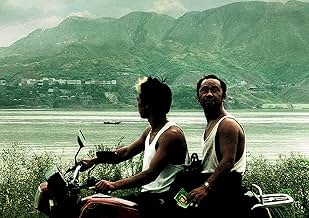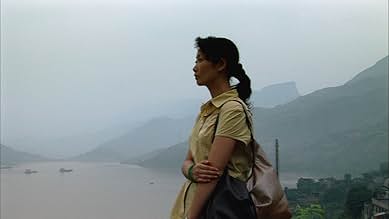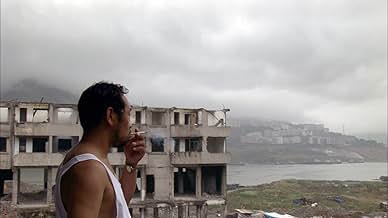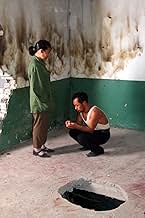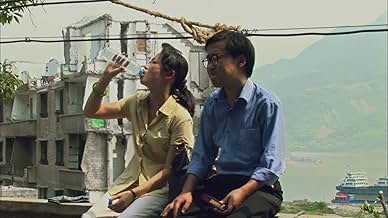VALUTAZIONE IMDb
7,3/10
7711
LA TUA VALUTAZIONE
Una città nella contea di Fengjie viene gradualmente demolita e allagata per far posto alla diga delle Tre Gole. Un uomo e una donna visitano la città per localizzare i loro coniugi separati... Leggi tuttoUna città nella contea di Fengjie viene gradualmente demolita e allagata per far posto alla diga delle Tre Gole. Un uomo e una donna visitano la città per localizzare i loro coniugi separati e diventare testimoni dei cambiamenti sociali.Una città nella contea di Fengjie viene gradualmente demolita e allagata per far posto alla diga delle Tre Gole. Un uomo e una donna visitano la città per localizzare i loro coniugi separati e diventare testimoni dei cambiamenti sociali.
- Regia
- Sceneggiatura
- Star
- Premi
- 15 vittorie e 14 candidature totali
Recensioni in evidenza
Reviewed at the North American premiere screening Tues. Sept. 12, 2006 at the Varsity 8 Theatre during the Toronto International Film Festival (TIFF).
I was lucky enough to be at TIFF screenings on Monday when it was announced that Sanxia Haoren was going to have a special one-time screening as a last minute addition to the Visions programme of TIFF 2006. I think the online tickets went fairly quickly and the theatre was packed with a considerable overflow of film writers & critics who had been unable to squeeze into the industry screening.
Sanxia Haoren has been given the title Still Life for international release, but the original Chinese title would seem to translate simply as Three Gorges Good People and it is in the vicinity of the dam's construction and the city demolitions and the people displacement entailed by it, that the film takes place. The film has a bookend plot of a miner Han Sanming (character's and actor's names are identical) who comes to the town of Fengjie to search for his estranged wife and child. The centrepiece story is that of a nurse named Shen Hong who is searching for her missing husband.
The dour faced Han Sanming is initially a cause of concern as it seems at the very start he is going to be swindled by tricksters on the river ferry but he soon shows that he can hold his own. We then think he is going to conned by a sarcastic motorcycle taxi driver who takes him to the location of his supposed house only for him to find it is now submerged under water. Things soon settle down for Han though as he finds lodging in a boarding house and work as a house demolition man on a crew with a brash young man who seems to have learned all his life lessons from the movies of Chow Yun Fat. Various humorous interludes (such as a young boy who sneaks cigarettes and roams around singing overly romantic songs which usually degenerate into an off-key screech by their end) and certain magic sequences (which I won't spoil) serve to bring comedy and wonder along the way. Several times the screen is seemingly chapter titled with the words "cigarette", "liquor", "tea" and "toffee", when these items occur during the plot, and any other meaning to this device eluded me. The journey of Shen Hong is similarly full of encounters with different characters on the way. I don't think the two stories actually intersected, but I may have been somewhat tired at this mid-way mark of TIFF as this screening went from 10:30 pm to 12:30 am.
The impression that the actors were perhaps simply playing versions of themselves was reinforced later in the week when I also caught the same director's documentary "Dong" which follows painter Liu Xiao-dong around locations at the Three Gorges Dam and it turned out that Han Sanming was actually one of the sturdy workmen that painter Liu was using for his models in a large multi-paneled painting of men. A blond-dye haired motorcycle taxi driver of Still Life makes a cameo appearance in Dong as well.
I found both of these films equally absorbing as they told stories of regular people in somewhat extreme life-changing situations and also that the 2 films complemented each other in a symbiotic way. Seeing one will enhance your appreciation of the other and vice versa. Both films are very deliberately paced but very lyrical and if you have an appreciation for slower paced film they are very rewarding. Also, if you did not have any concept of the magnitude of what is going on in the Three Gorges area, these films will give you a first hand view.
The director Jia Zhang-ke was not in attendance for the North American premiere, as he presumably was still in Venice celebrating his win of the Golden Lion for this film and 2 awards for the documentary.
I was lucky enough to be at TIFF screenings on Monday when it was announced that Sanxia Haoren was going to have a special one-time screening as a last minute addition to the Visions programme of TIFF 2006. I think the online tickets went fairly quickly and the theatre was packed with a considerable overflow of film writers & critics who had been unable to squeeze into the industry screening.
Sanxia Haoren has been given the title Still Life for international release, but the original Chinese title would seem to translate simply as Three Gorges Good People and it is in the vicinity of the dam's construction and the city demolitions and the people displacement entailed by it, that the film takes place. The film has a bookend plot of a miner Han Sanming (character's and actor's names are identical) who comes to the town of Fengjie to search for his estranged wife and child. The centrepiece story is that of a nurse named Shen Hong who is searching for her missing husband.
The dour faced Han Sanming is initially a cause of concern as it seems at the very start he is going to be swindled by tricksters on the river ferry but he soon shows that he can hold his own. We then think he is going to conned by a sarcastic motorcycle taxi driver who takes him to the location of his supposed house only for him to find it is now submerged under water. Things soon settle down for Han though as he finds lodging in a boarding house and work as a house demolition man on a crew with a brash young man who seems to have learned all his life lessons from the movies of Chow Yun Fat. Various humorous interludes (such as a young boy who sneaks cigarettes and roams around singing overly romantic songs which usually degenerate into an off-key screech by their end) and certain magic sequences (which I won't spoil) serve to bring comedy and wonder along the way. Several times the screen is seemingly chapter titled with the words "cigarette", "liquor", "tea" and "toffee", when these items occur during the plot, and any other meaning to this device eluded me. The journey of Shen Hong is similarly full of encounters with different characters on the way. I don't think the two stories actually intersected, but I may have been somewhat tired at this mid-way mark of TIFF as this screening went from 10:30 pm to 12:30 am.
The impression that the actors were perhaps simply playing versions of themselves was reinforced later in the week when I also caught the same director's documentary "Dong" which follows painter Liu Xiao-dong around locations at the Three Gorges Dam and it turned out that Han Sanming was actually one of the sturdy workmen that painter Liu was using for his models in a large multi-paneled painting of men. A blond-dye haired motorcycle taxi driver of Still Life makes a cameo appearance in Dong as well.
I found both of these films equally absorbing as they told stories of regular people in somewhat extreme life-changing situations and also that the 2 films complemented each other in a symbiotic way. Seeing one will enhance your appreciation of the other and vice versa. Both films are very deliberately paced but very lyrical and if you have an appreciation for slower paced film they are very rewarding. Also, if you did not have any concept of the magnitude of what is going on in the Three Gorges area, these films will give you a first hand view.
The director Jia Zhang-ke was not in attendance for the North American premiere, as he presumably was still in Venice celebrating his win of the Golden Lion for this film and 2 awards for the documentary.
Still Life touches upon all the problems surrounding the controversial issue of the construction of the Three Gorges Dam but it only presents short glimpses of this reality, like colorful splashes of paint onto a palette: we see the young sixteen year old begging the outsider to take her away and find a job for her as a maid in a big city, panels indicating the phases of demolition, the word "demolition" painted outside people's residences, workers pulling down constructions, land compensation, relocation and myriads of hints at the inside stories of the people: helplessness, cynicism, acceptance, nostalgia.
The plot is very simple: a coal miner coming to the Three Gorges in search of his wife, whom he hasn't seen in sixteen years and a woman in search of her husband, whom she hasn't seen in three years. The human stories, set against the background of the Three Gorges and the Yangtze River, are fleeting, fragile, ethereal. The characters' journey is both physical and psychological. They both have traveled from Shanxi province in search of their wife and husband but their journey is also a journey into consciousness, nostalgia, loss and the past. Besides, it is also a crucial step before a new future. Along with the nostalgia and the lingering on what is lost, there is also a constant need to make decisions and move on, which is what the characters do. We, spectators, follow the characters at the same time as we/they make a journey into the Three Gorges. The connection between the characters and the landscape is obvious. The journey is not only into the characters' past but also a hint at the past of the Three Gorges, at all the villages which have been pulled down and at those who are about to disappear. The sense of loss in the characters' lives is unmistakably connected to the Three Gorges, to that which is already lost and to what is about to be taken away.
The film is definitely a beautiful and poetic reflection on time. The coal miner, Han Sanming, keeps the address of his former wife written on an old pack of cigarettes. When a young boy asks him what they are, he replies that they used to be the best brand of cigarettes sixteen years ago. The boy says he is too nostalgic, and to this, Han Sanming answers gravely that "we all remember our pasts". Yet Still Life is not only about time lost. There are also celebrations of the present. Han Sanming's determination to try again with his ex-wife is a note of optimism and hope. Various scenes in the film also show villagers dancing, enjoying a singing performance, where the camera lingers on their expressions of joy and enthusiasm, a clear celebration of life.
All the films I've seen about the Three Gorges and the Dam share a strong emphasis on the visual, arguably because the gripping power of the landscape cannot make it otherwise. Still Life is not an exception. One of its signs of distinction, which greatly accounts for the beauty of the film, is the way in which it is shot. The motion of the camera is always very slow and contemplative. It moves along the river banks as well as along objects and characters' faces in a fashion similar to that of a ship moving along the river. This slow, balanced, contemplative motion also recalls the movement of water, and brings to the viewer notions of fluidity, transformation and renewal. The background of the Three Gorges and the Yangzte is always there. Many takes show the contrast of the characters' insignificance against the overwhelming vastness of the landscape, and this is also done with objects. As Han Sanming contemplates a 10 Yuan note, the close take of the note is again set against the background of the Gorges. To all this must be added the attention to detail: the humanity of people's conversations, the taste of local Sichuan people, the colors, the contrasts. To me, Still Life is not only a cinematographic accomplishment. It is also evidence that people still remember, at this very important moment in time, the Three Gorges and its people.
The plot is very simple: a coal miner coming to the Three Gorges in search of his wife, whom he hasn't seen in sixteen years and a woman in search of her husband, whom she hasn't seen in three years. The human stories, set against the background of the Three Gorges and the Yangtze River, are fleeting, fragile, ethereal. The characters' journey is both physical and psychological. They both have traveled from Shanxi province in search of their wife and husband but their journey is also a journey into consciousness, nostalgia, loss and the past. Besides, it is also a crucial step before a new future. Along with the nostalgia and the lingering on what is lost, there is also a constant need to make decisions and move on, which is what the characters do. We, spectators, follow the characters at the same time as we/they make a journey into the Three Gorges. The connection between the characters and the landscape is obvious. The journey is not only into the characters' past but also a hint at the past of the Three Gorges, at all the villages which have been pulled down and at those who are about to disappear. The sense of loss in the characters' lives is unmistakably connected to the Three Gorges, to that which is already lost and to what is about to be taken away.
The film is definitely a beautiful and poetic reflection on time. The coal miner, Han Sanming, keeps the address of his former wife written on an old pack of cigarettes. When a young boy asks him what they are, he replies that they used to be the best brand of cigarettes sixteen years ago. The boy says he is too nostalgic, and to this, Han Sanming answers gravely that "we all remember our pasts". Yet Still Life is not only about time lost. There are also celebrations of the present. Han Sanming's determination to try again with his ex-wife is a note of optimism and hope. Various scenes in the film also show villagers dancing, enjoying a singing performance, where the camera lingers on their expressions of joy and enthusiasm, a clear celebration of life.
All the films I've seen about the Three Gorges and the Dam share a strong emphasis on the visual, arguably because the gripping power of the landscape cannot make it otherwise. Still Life is not an exception. One of its signs of distinction, which greatly accounts for the beauty of the film, is the way in which it is shot. The motion of the camera is always very slow and contemplative. It moves along the river banks as well as along objects and characters' faces in a fashion similar to that of a ship moving along the river. This slow, balanced, contemplative motion also recalls the movement of water, and brings to the viewer notions of fluidity, transformation and renewal. The background of the Three Gorges and the Yangzte is always there. Many takes show the contrast of the characters' insignificance against the overwhelming vastness of the landscape, and this is also done with objects. As Han Sanming contemplates a 10 Yuan note, the close take of the note is again set against the background of the Gorges. To all this must be added the attention to detail: the humanity of people's conversations, the taste of local Sichuan people, the colors, the contrasts. To me, Still Life is not only a cinematographic accomplishment. It is also evidence that people still remember, at this very important moment in time, the Three Gorges and its people.
Ancient towns have been submerged along the Yangtse River in China as part of the Three Gorges Dam project. Jia Zhang-Ke has created a contemplative and compassionate human drama set in the region, depicting two separate protagonists attempting to locate missing ones who lived in areas now underwater.
I'm not a great fan of high definition digital video photography, but this sublime film takes advantage of the benefits of the technology while avoiding most of the pitfalls. I was seriously sleep-deprived while watching the film and never got close to nodding off, even though there are very long takes where little seems to happen. Yet in takes, there are many passing details, the beautiful movements of camera taking in rich and authentic details of people, situations, implements, household paraphernalia and gorgeous sweeping vistas. The latter appeared to be enhanced using filters, which seemed to compensate for the loss of aesthetics that comes from not shooting on 35mm film. This film was visually beautiful, though that really only served what was an extremely well-made film.
As a lover of world cinema, I found the attention to detail fascinating. The director seemed to be sharing the idiosyncrasies of the local culture, customs and demeanour with a real sense of compassion and humanitarianism. I found it poetic, uplifting and moving. Paraphrasing Melbourne International Film Festival executive director Richard Moore's in introduction by quoting the director (who was in attendance as a guest of the festival): "I originally wanted to make films that would change the world... I now realise this is not possible, and I just wish to make films that make people sigh." It worked on me.
I'm not a great fan of high definition digital video photography, but this sublime film takes advantage of the benefits of the technology while avoiding most of the pitfalls. I was seriously sleep-deprived while watching the film and never got close to nodding off, even though there are very long takes where little seems to happen. Yet in takes, there are many passing details, the beautiful movements of camera taking in rich and authentic details of people, situations, implements, household paraphernalia and gorgeous sweeping vistas. The latter appeared to be enhanced using filters, which seemed to compensate for the loss of aesthetics that comes from not shooting on 35mm film. This film was visually beautiful, though that really only served what was an extremely well-made film.
As a lover of world cinema, I found the attention to detail fascinating. The director seemed to be sharing the idiosyncrasies of the local culture, customs and demeanour with a real sense of compassion and humanitarianism. I found it poetic, uplifting and moving. Paraphrasing Melbourne International Film Festival executive director Richard Moore's in introduction by quoting the director (who was in attendance as a guest of the festival): "I originally wanted to make films that would change the world... I now realise this is not possible, and I just wish to make films that make people sigh." It worked on me.
The comment which was written before mine gives a great and brilliant explanation of the social problems and facts that involves this film, so I am not going to repeat it. I prefer to talk about another one of the most relevant aspects of this movie: the photography, magisterially directed by Yu Likwai. Sometimes one can have the impression to be watching a photo album, further than a movie. There are no bad or ugly photo-grams in this film. Every image contains a really fine sense of photography as an art, including superb landscapes, exiting colors, and intelligent compositions with everything and everybody in the right place, without unaesthetic gaps. A pleasure for eyes and soul.
I've seen lots of presentations by businesspeople and academics about Chinese industry, development, social problems, politics, progress, environmental disasters, etc. etc. I've never seen anything like this. It's China on the ground - actually a town about to be submerged by the Three Gorgest Dam project. The title translation of "Three Gorges Good People" is right - these are ordinary folks who endure, persist, help each other out, etc. in a mixed landscape of natural beauty, building, poverty, and destruction that has to be seen to be understood. The story of the dam shapes everybody's life without actually determining or washing them out. Definitely try to see this if you have any interest at all in China today.
Lo sapevi?
- QuizRanked second in French film magazine Cahiers du cinéma's top 10 list of the best pictures of 2007, tied with Inland Empire - L'impero della mente (2006) and Grindhouse - A prova di morte (2007).
- ConnessioniFeatures A Better Tomorrow (1986)
I più visti
Accedi per valutare e creare un elenco di titoli salvati per ottenere consigli personalizzati
- How long is Still Life?Powered by Alexa
Dettagli
Botteghino
- Budget
- 10.000.000 CN¥ (previsto)
- Lordo Stati Uniti e Canada
- 76.983 USD
- Fine settimana di apertura Stati Uniti e Canada
- 12.744 USD
- 20 gen 2008
- Lordo in tutto il mondo
- 2.504.465 USD
- Tempo di esecuzione1 ora 51 minuti
- Colore
- Mix di suoni
- Proporzioni
- 1.78 : 1
Contribuisci a questa pagina
Suggerisci una modifica o aggiungi i contenuti mancanti





